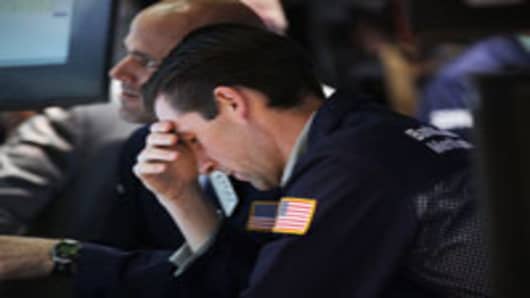Investors spent most of the summer believing that central bankers would protect them from the looming European debt threat, only to find in recent days that they may be wrong.
Volatility has returned both on Wall Street and in the streets of Europe, where Spaniards have been protesting austerity measures, and, in doing so, sparked the realization that the sovereign debt crisisis far from over.
Stock markets around the world have been trading lower, generating some worries that Europe could put a halt to what has been an otherwise powerful 2012 rally.
"When everybody is all-in and all-long, the market is priced for perfection," says Walter Zimmerman, senior technical analyst at United-ICAP in Jersey City, N.J. "The market will only be able to tolerate good things happening. Anything that starts unfolding in the other direction, the market is going to be extremely vulnerable."
The increased nervousness has come even though European Central BankPresident Mario Draghi has assured the markets that he stands at the ready to provide help to euro zone countries struggling with debt issues.
At the same time, Federal Reserve Chairman Ben Bernanke recently announced a third round of quantitative easing with the goal of driving down the U.S. unemployment rate.
But after Spanish leaders announced plans to enact the type of budget austerity measures — including eliminating holiday bonuses for workers — necessary to get the ECB's help, protests erupted and shook world markets.
"Anytime you get bond yields rising and equity prices falling because of another blow-up on euro zone funding, then it just takes away all of the stitching that the ECB and various financial leaders have cobbled together over the last three or four months," says Andrew Wilkinson, chief economic strategist at Miller Tabak in New York.
As has been the case with the crisis during previous flare-ups, the damage is felt not only in Europe but also across the world, into the American market as well as China and elsewhere.
Zimmerman says that U.S. stocksare particularly vulnerable because of how much they've surged since Draghi calmed the markets.
That, he adds, also will make the Fed's QE3 program less likely to succeed, at least in terms of driving stock prices higher, because the first two rounds were implemented when stocks were slumping and in need of a lift, not in the middle of a violent rally higher like this time.
"Expecting a March 2009-type springback from current levels is a ludicrous triumph of hope over reason," Zimmerman says. "There's just no way that's going to happen."
To be sure, it's a little early to say that the market is in danger of a steep correction, considering the Standard & Poor's 500 is off short of 2 percent since its recent high when QE3 was announced.
While stocks in Spainwere off 3 percent and Italy fell 2 percent in Wednesday trading, the U.S. market hovered around breakeven.
"There's still a lot of resilience in this market. There's still a lot of money that would like to get involved," says Peter Costa, president of Empire Executions in New York. "They want to be in a place that for the time being, even if it doesn't have the greatest growth prospects, is still a lot better than Europe."
Investors worried about a sustained Europe-driven pullback should keep an eye on the stocks that have done the best during the rally that began in early June, says Kathy Boyle, president of Chapin Hill Advisors in New York.
Specifically, she points to companies such as Amazon, Apple, Google, General Electric and Toll Brothers.
"Once they start the other way, those that ran up the most are generally the hardest hit," Boyle says. "If the big guys start to pull money out, they're like a freight train. You've got to get out of the way."
Boyle sees the S&P 500 sinking to as low as 1,200 by year's end as investors realize that dangers such as the European crisis and the fiscal problems in the U.S. will remain unresolved.
She also uses the expression "priced for perfection" to describe the current market.
"Sell in May and go away works most of the time. This year it didn't. Now what?" she says. "We have so many bumps in the road. God forbid any of these unknowns hit. That could be anything."



